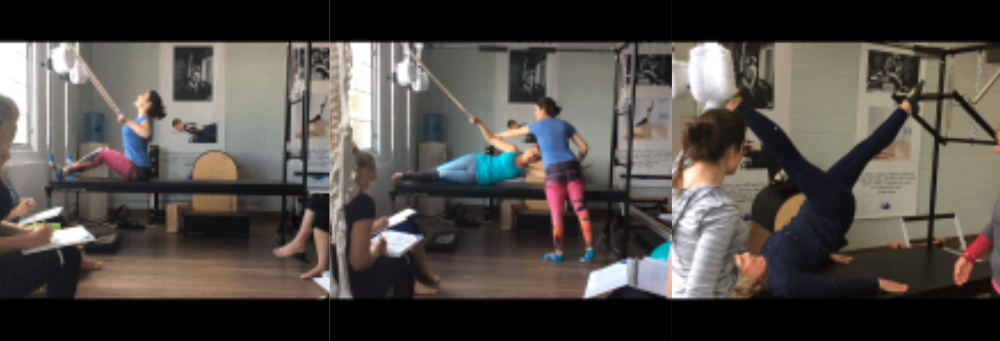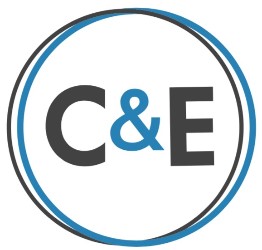
In this penultimate weekend, the Teacher Trainees are excited to tackle even more challenging progression in the vast Pilates repertoire. Tanis has customized a manual of Chair and Cadillac exercises geared to our current abilities and teaching level, equally good for self-practice and teaching advanced clients. Since illustrations or photos don’t always do justice to the more advanced movement sequences, videos of Tanis demos will help to remind us how to practice and teach them.
We play a game that Tanis calls “spot the exercise within the exercise.” because these more complex exercises are actually interesting combinations of repertoire moves, but more dynamic, fluid and requiring ever more incremental control. As the support of the apparatus is reduced, the challenges increase, therefore it’s even more important we do the exercises correctly. By now, though, we are extremely familiar with the shapes and know or feel where the work should come from. Even for those of us with limitations who aren’t able to do all the exercises, understanding the ESSENCE of each exercise is what’s really important. A testament to the wisdom in progression (and months of practice!)
We ring in Saturday morning with an evaluation exam. As we review the answers, Tanis reiterates that we should focus less on how much we don’t know but recognize what we do know. She says “proficiency in teaching will come” with seeing more bodies and recognizing the patterns, which will reinforce what we already do know. Tanis encourages trainees to trust themselves and not merely imitate other teachers’ styles; it’s imperative to develop a personal groove, she says, as long as it’s based on the method.
Before we tackle more challenging planes of movement in back extension and inversion work, we address the trust and guarding issues that come with changing our orientation to gravity and losing physical connection. Some comic relief punctuates our session as usual: while referring to pelvic bone movement, Tanis uses the technical term “nutation” but all of us hear “mutation” instead and so naturally joke about how Pilates is facilitating our mutation –- a good analogy for the processes our bodies and minds are undergoing this year. As the TTs take turns to try some newer moves, I note the happy surprise in their comments: “not as hard as looks” or the more modest, “…must be getting a bit better.”
Some other key things covered or reinforced this weekend:
- How breath becomes even more critical in more complex moves to support the body and for fluidity and flow.
- Where and when modifications can help and/or where and when medical intervention might be necessary with issues of Spondylolithesis, degenerative disc disease, or facet joint locks.
- How to effectively use the studio: so many Swans and Teasers…
- How to adjust for the variety in bodies with geometry and physics.
- Why and how to use the various Pilates bars, and where-to-pad-a-cranky-knee type of tips.
- The differences of open vs closed kinetic exercises.
- The importance of transitions and of the exercises within exercises (such as, how to turn a Parakeet into a Monkey!)
As we near the end of our formal training year, when and how to progress in the repertoire becomes relevant. Pilates teachers are always building (or rebuilding) bodies from the ground up and addressing overall problems in the process, often returning to basics and layering concepts. Choosing exercises is based on so many things we now understand, including: a body’s experience with Pilates; flexibility; awareness; connection; ROM; balance; and state of health. Naturally the goal is to challenge the body safely and effectively, within the guidance of the system and repertoire.
Later, as we get to experience teaching the Cadillac’s Straps and Trapeze to each other, the deeper traction of ballet stretch series once again showcases a classic “cheat.” The foot will be tempted to move five times more and replace the natural movement of the hip joint. So we are reminded to make sure the work comes from the head of the femur.
And because we aren’t supposed to try anything in studio time that we haven’t been officially taught, our anticipation is keenest for the Fuzzy straps in the Inversions. This isn’t a case of something that is hard to perform but rather a position that is a bit more difficult to get into and to support, so once again, guidance and practice turn out to be invaluable. Hanging from our ankles in the Fuzzy straps, partially supported, releases tight spots, and allows gravity to apply traction to our fascia. Ahhhhhhh.
And as we go deeper and further on our Pilates journey, we hear Tanis repeat one of her most helpful and polysemantic cues of the weekend: “One. More. Inch!”
